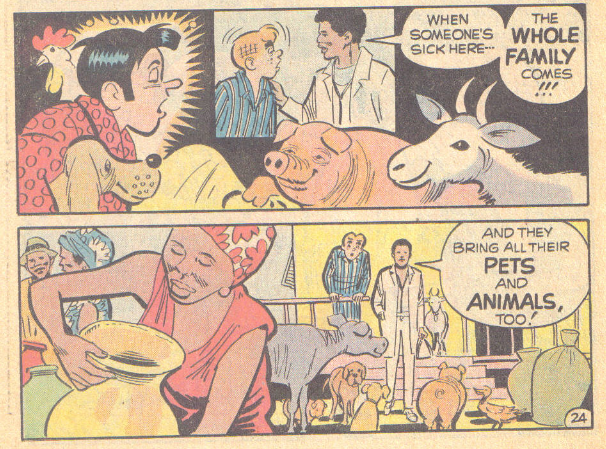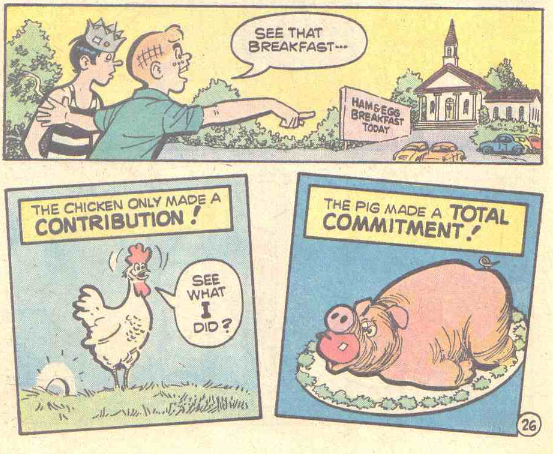Spire Comics: The... Christian Adventures of Archie Andrews?
Comics are weird; I feel that we have established this on You Don't Read Comics by now. From the Teenage Mutant Ninja Turtles convincing Hitler to kill himself, to Star Wars comics trying to expand the universe with big green rabbits, to a race of Grinches trying to eat Santa on Christmas with the Enterprise crew, it's a thing.
And today, we will look at one of the more bizarre things I have honestly ever come across. Seeing what I've written about before, that's saying something.
My grandparents had a lot of comics lying around from when my mom and uncle were kids. Old Marvel Star Wars comics, issues of Dell Comics' forays into Looney Tunes and Disney, and even Archie comics. But some of these were more than a little off. While some of the comics were digest collections picked up off the newsstands by grandma when she went shopping, several old comics had some interesting covers and a logo I never recognized.
I mean, Archie's jalopy was infamous for breaking down, but his car got an entire comic? That blew my young mind… but if Jughead's dog Hot Dog could get a comic of his own in 1989, anything was possible. And I wasn't sure who Spire was, but they must have been a branch of Archie Comics or something. Inside the comic, it was… like almost any other Archie comic you would see published today. Antics, hijinks, Archie crashing his jalopy into Mr. Lodge's pool and then trying to upgrade his car into a motorhome to compete with Reggie.
On page 12, however, I noticed something odd.
As it turns out, Spire Comics was actually a rare Christian comic imprint from the Fleming H Revell company. Founded in 1870, they were a book company intended to make "practical books" for the everyday Christian life. Where this intersects with Archie, and the comic world makes for a truly bizarre story.
Al Hartley, the man credited on the covers and interiors of nearly all of Spire's creative output, was a man who worked in the comics industry during one of its lowest points. In the dark times after World War 2, comic book sales were dipping horribly under superheroes, and other brands of comics that were found to be "detestable" by the soccer moms of the day were soon banned in the early 1950s. Al himself would find work with Marvel Comics, then known as Timely (and later Atlas). In fact, Hartley worked with Stan Lee many times throughout the years he worked at Marvel, becoming one of the first artists to work under the Marvel Method of Comics. This is where the writer comes up with a plot, the artist creates, and the writer comes in later to dialogue the pages.
However, Marvel's launch of Superheroes truly wasn't his bag. Al would later relate that he was more comfortable with romance and teenage stories, like his decade-long run on Patsy Walker… who would later be relaunched in the 1970s as the hero The Cat. And later on renamed Hellcat.
I was not expecting a direct link between Christian Archie and Hellcat, but comics are weird.
Al would become a born-again Christian in 1967, and this would cause some issues with Marvel. After being asked to work on some men's magazines published by Marvel's owner Martin Goodman, which would involve nudity and sexual antics, Al chose to quit rather than continue. Hartley would find himself working at Archie Comics not long after, and also taking freelance work where he could. Finally, here is where the two weird histories collide to create Christian Archie.
As a Born Again Christian, Al felt it was his job to "infuse Christian morals" into Archie. He was told to dial it back and actually did in the comics published by Archie. However, Fleming H Revell publishers had hired him in 1972 to work on adaptations of popular Christian novels like The Cross and the Switchblade and The Hiding Place. Hartley and Revell would actually launch Spire Comics with the intent to publish comics for Christians and to be used as ways to reach out to Non-Christians. Al also had the idea of reaching out to the then-President of Archie John Goldwater to ask about using the Archie characters in these comics. As you might guess, he agreed.
My apologies for the quality of the cover image. It seems literally no one has archived this comic online, much less has a good image of the cover.
Spire would publish comics until 1988 under this arrangement, with 19 of them under the Archie agreement. There would also be 12 comics that are closer to biographies, 6 straight bible stories, 4 adaptations of modern Christian works, and a whole bunch of wholesome kids comics. To be honest, there is a ton of quality in these comics, and Al Hartley was a fairly great artist for the era he made comics in.
Aside from using Archie's car as a metaphor for coming to Jesus, there were other subjects touched upon by Al and his desire to reach non-Christians using the Archie pals. For example, Archie's Sonshine would actually make a modern version of Jesus' Sermon on the Mount as a tale, with some… unique interpretations.
Some parts of these comics have aged hilariously.
And yes, that denim-clad man is basically 1970s White Jesus. I never said these comics were particularly subtle.
However, these comics are far from a timeless example of comics. Aside from the hilarity of Liberace being featured in a Christian comic, the comic Archie's World from 1976 has some incredibly disturbing views of other cultures. Focusing on missionaries and why they go to other cultures, we have The United Republic of Tanzania...
India...
Myanmar...
Hong Kong
And general racism against other cultures and their views when they’re not white.
Meanwhile, Archie Gets a Job from 1977 actually shilled for the newest books from Revell publishing!
Along with a hilariously bad metaphor for how God would like for you to follow him:
But as mentioned earlier, pious Archie comics weren't Spire and Hartley's only output. Rather than only focusing on talking about God, they also told Christian stories based on novels and the lives of others. Perhaps the most infamous is… Hansi, The Girl Who Loved the Swastika.
I genuinely apologize for all the co-workers who are staring at you now. I experienced this a bit while researching.
Yep.
Hoo boy.
This bad based on the life of evangelist Maria Ann Hirschmann, who lived in Nazi Germany, only to eventually emigrate to the United States during the Cold War. The comic is hardly subtle, flying swastikas everywhere, but does its best to present the source material with respect. Unlike the Archie comics, these books weren't always intended for the same young kids.
Also, Hitler!
At least we now know what… Hitler looks like in the Archie style? Oh god.
And, of course, it ends with some good ol' Cold War propaganda.
Yes, because claiming you worship God makes it all ok.
As for other original content, we have In His Steps. An adaptation of a popular novel in 1977 which brought forth the popular "What Would Jesus Do" question, while also providing this hilarious non-sequitur:
Perhaps the best execution of faith and teaching comes from 1974's Gospel Blimp. The comic shows a congregation getting carried away with reaching people by using a blimp to advertise God.
The actual message doesn't come until the final pages when it's revealed that the thing that brings people to God is actually just interacting with them as people and living what you preach.
While I won't comment about the religious views espoused within Spire's comic selection, they are about as you would expect: putting your life within the hands of God, following his teachings, and generally being a better human being. The end result can be anywhere from delightfully enjoyable in the case of most Archie offerings, to the utterly bizarre like with Hansi.
However, regardless of the content within the book, there is a good sense of being genuine about religion. While the books get preachy from time to time, it avoids making any major Archie character out to be a fool or put down other religions explicitly. The cultural issues of Archie's Word aside, anyhow, the comics still mean well in most respects in spite of the lack of diversity. At the very best, the comics come off as an earnest passion project from one man.
At the worst… well, at least the art is nice.
It is highly unlikely these comics will ever be collected, to be honest. The content they cover has either been covered better in recent years, been forgotten by time, or generally won't always appeal to modern readers or anyone outside of Archie Comics historians. Not to mention, these comics were never owned by Archie, and the company Revell was purchased by Baker Publishing in 1992, making the situation even more complicated. Lord only knows where the original art or prints have gone to as well. However, they can be rather commonly found on places like eBay, and a few issues have even been preserved by comics archivists.
If any of these books sound interesting, it can't hurt to hunt a few down. A few of these are worth reading for some genuinely fun Archie antics, while others can be enjoyed for the disaster within. At the very least, Al Hartley made some comics that can't really be forgotten about, even if the material hasn't aged as well as the paper it was printed on.





























